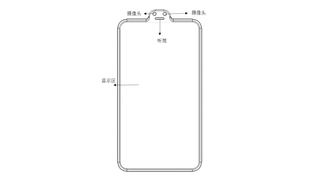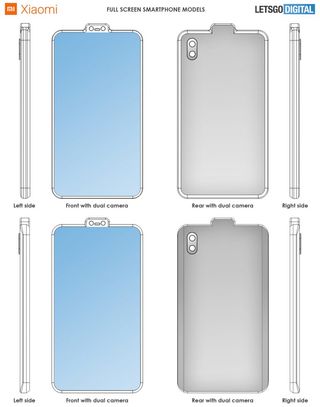Xiaomi has found a way to make the smartphone notch even uglier
Patent suggests something nobody wants

Xiaomi has come up with an idea that solves the problem of creating an all-screen phone, but doesn't rely on a mechanical, pop-up notch... and you're probably not going to like it.
Rather than rely on smooth, clear lines around the outside of the handset, a patent filed in May 2018 and spotted by Tiger Mobiles details a phone with two cameras that live above the display, in a weird 'backwards notch'.
- Will the iPhone 11 pack a similar notch?
- The OnePlus 7 will probably still keep a notch
- How would a large bump affect the best camera phones?
The result is a rather squat-looking robotic little phone, which has an unencumbered display to look at.

Dutch site LetsGoDigital has had some wider images made from the patents filed with the China National Intellectual Property Administration (CNIPA), showing how the phone could look from all angles:

What problem does this solve?
The notch, the small cutout at the top of many button-less phones, is designed to allow phone manufacturers to extend the screen to the top of the bezel - but still find a place to put the front-facing cameras (and in the case of Apple's iPhone XS, the IR sensor for facial recognition).
This gets in the way of certain content and has been certainly... divisive since it was made popular on the iPhone X. Some brands have made things a little smaller since, but ultimately it breaks the clean lines of an 'all-screen' phone.
The next option has been the punch-hole design, most commonly found on the new Samsung Galaxy S10. This is small hole in the screen for the camera, and preserves as much screen real estate as possible.
Get daily insight, inspiration and deals in your inbox
Sign up for breaking news, reviews, opinion, top tech deals, and more.
The final design, and one championed by Xiaomi previously in the Mi Mix 3, is the slide up camera, one that emerges (either as a motorised element or one slid up manually by the user) - at least this bump doesn't require waiting for the cameras to slide up, or require additional user action.
However, we can't see it catching on. The fact the patent was filed last year, at the height of the desires to have an all-screen phone, mean the design was probably just more defensive if it ever came that Xiaomi needed another option.
- The Samsung Galaxy Note 10 could be the brand's most beautiful phone yet

Gareth has been part of the consumer technology world in a career spanning three decades. He started life as a staff writer on the fledgling TechRadar, and has grew with the site (primarily as phones, tablets and wearables editor) until becoming Global Editor in Chief in 2018. Gareth has written over 4,000 articles for TechRadar, has contributed expert insight to a number of other publications, chaired panels on zeitgeist technologies, presented at the Gadget Show Live as well as representing the brand on TV and radio for multiple channels including Sky, BBC, ITV and Al-Jazeera. Passionate about fitness, he can bore anyone rigid about stress management, sleep tracking, heart rate variance as well as bemoaning something about the latest iPhone, Galaxy or OLED TV.
Most Popular




